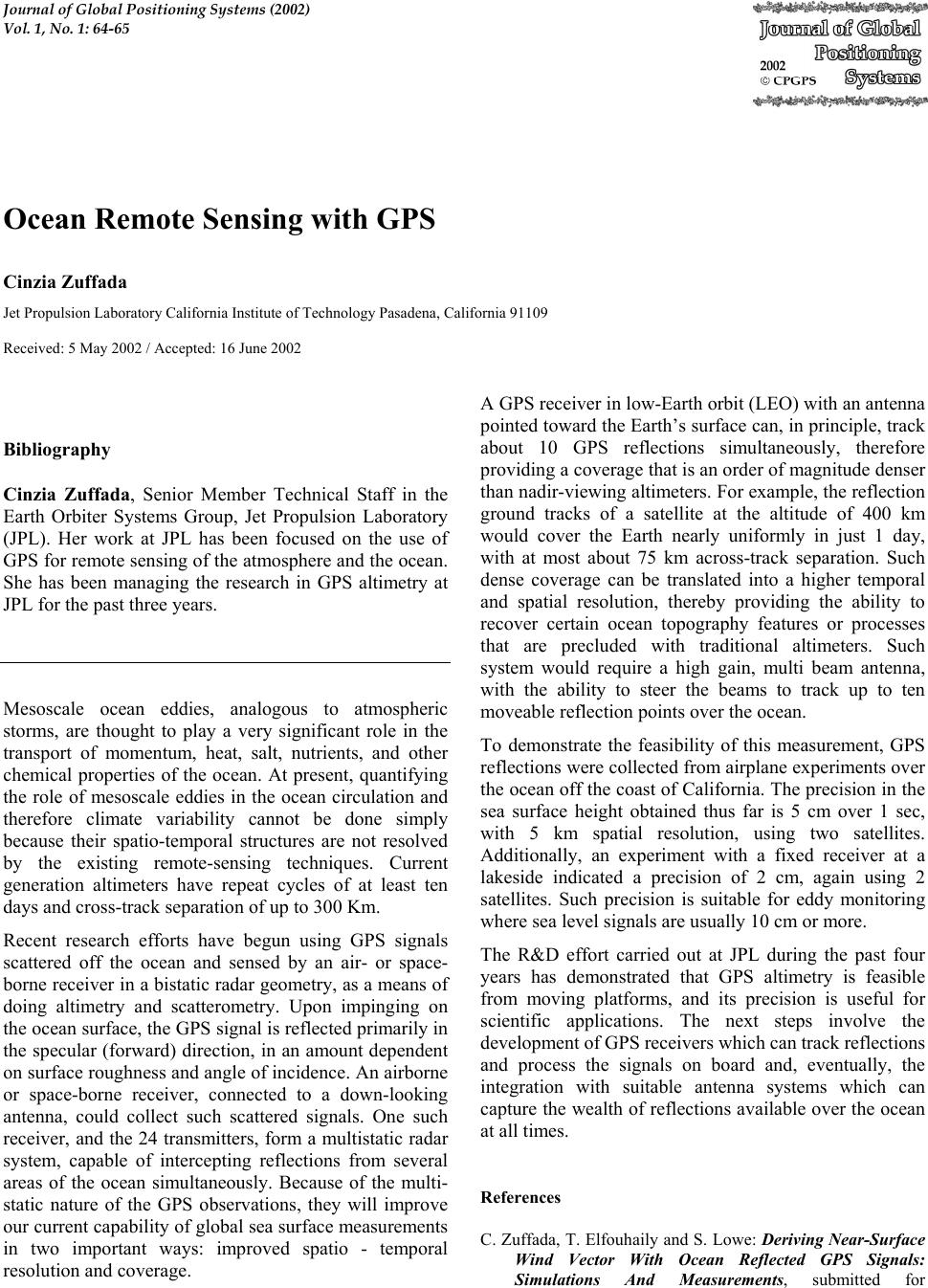Paper Menu >>
Journal Menu >>
 Journal of Global Positioning Systems (2002) Vol. 1, No. 1: 64-65 Ocean Remote Sensing with GPS Cinzia Zuffada Jet Propulsion Laboratory California Institute of Technology Pasadena, California 91109 Received: 5 May 2002 / Accepted: 16 June 2002 Bibliography Cinzia Zuffada, Senior Member Technical Staff in the Earth Orbiter Systems Group, Jet Propulsion Laboratory (JPL). Her work at JPL has been focused on the use of GPS for remote sensing of the atmosphere and the ocean. She has been managing the research in GPS altimetry at JPL for the past three years. Mesoscale ocean eddies, analogous to atmospheric storms, are thought to play a very significant role in the transport of momentum, heat, salt, nutrients, and other chemical properties of the ocean. At present, quantifying the role of mesoscale eddies in the ocean circulation and therefore climate variability cannot be done simply because their spatio-temporal structures are not resolved by the existing remote-sensing techniques. Current generation altimeters have repeat cycles of at least ten days and cross-track separation of up to 300 Km. Recent research efforts have begun using GPS signals scattered off the ocean and sensed by an air- or space- borne receiver in a bistatic radar geometry, as a means of doing altimetry and scatterometry. Upon impinging on the ocean surface, the GPS signal is reflected primarily in the specular (forward) direction, in an amount dependent on surface roughness and angle of incidence. An airborne or space-borne receiver, connected to a down-looking antenna, could collect such scattered signals. One such receiver, and the 24 transmitters, form a multistatic radar system, capable of intercepting reflections from several areas of the ocean simultaneously. Because of the multi- static nature of the GPS observations, they will improve our current capability of global sea surface measurements in two important ways: improved spatio - temporal resolution and coverage. A GPS receiver in low-Earth orbit (LEO) with an antenna pointed toward the Earth’s surface can, in principle, track about 10 GPS reflections simultaneously, therefore providing a coverage that is an order of magnitude denser than nadir-viewing altimeters. For example, the reflection ground tracks of a satellite at the altitude of 400 km would cover the Earth nearly uniformly in just 1 day, with at most about 75 km across-track separation. Such dense coverage can be translated into a higher temporal and spatial resolution, thereby providing the ability to recover certain ocean topography features or processes that are precluded with traditional altimeters. Such system would require a high gain, multi beam antenna, with the ability to steer the beams to track up to ten moveable reflection points over the ocean. To demonstrate the feasibility of this measurement, GPS reflections were collected from airplane experiments over the ocean off the coast of California. The precision in the sea surface height obtained thus far is 5 cm over 1 sec, with 5 km spatial resolution, using two satellites. Additionally, an experiment with a fixed receiver at a lakeside indicated a precision of 2 cm, again using 2 satellites. Such precision is suitable for eddy monitoring where sea level signals are usually 10 cm or more. The R&D effort carried out at JPL during the past four years has demonstrated that GPS altimetry is feasible from moving platforms, and its precision is useful for scientific applications. The next steps involve the development of GPS receivers which can track reflections and process the signals on board and, eventually, the integration with suitable antenna systems which can capture the wealth of reflections available over the ocean at all times. References C. Zuffada, T. Elfouhaily and S. Lowe: Deriving Near-Surface Wind Vector With Ocean Reflected GPS Signals: Simulations And Measurements, submitted for  Zuffada: Ocean Remote Sensing with GPS 65 publication in Remote Sensing of the Environment, March 2001. A.K. Fung, C. Zuffada and C. Y. Hsieh, Incoherent Bistatic Scattering from the Sea Surface at L-Band, IEEE Transactions on Geoscience and Remote Sensing, Vol. 39, no. 5, pp. 1006-1012, May 2001. Lowe, S. T., C. Zuffada, Y. Chao, P. Kroger, J. L. LaBrecque, L. E. Young, Five-cm-Precision Aircraft Ocean Altimetry Using GPS Reflections, accepted for publication in Geophys. Res. Lett., February 02. R.Treuhaft, S. Lowe, C. Zuffada, and Y. Chao: 2-Cm GPS Altimetry Over Crater Lake, Geophys. Res. Lett., 28, 23, p. 4343-4346, December 2001. |

